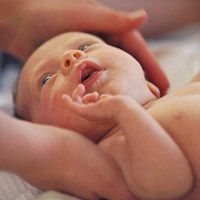Article
Pulse Oximetry Law Finds Newborns' Heart Problems
Author(s):
Undetected neonatal heart defects can cause a variety of serious problems, including an increased risk of death. A recently enacted New Jersey law mandating screening for congenital heart defects has uncovered cases of congenital heart problems and likely saved lives.

About 9 of every babies born in the US have congenital heart defects. When undetected these conditions go untreated and put these children at risk of disability and even death. But a 3-year-old New Jersey law, believed to be the first in the US, requires pulse oximetry screenings of newborns. The goal is to find these problems and treat them early.
So far, according to research presented in a poster session today at the American Heart Association's Scientific Sessions in Chiago, pulse oximetry screenings are saving the lives of some babies with congenital heart defects.
Screening for congenital heart defects with pulse oximetry identified newborn babies with
previously unsuspected critical congenital heart defects (CCHD), according to research presented at
the American Heart Association’s Scientific Sessions 2014.
Babies with undetected CCHD have a
significant increased risk of disability or death.
Since the screenings began, 13 newborns with these problems have been identified. Their conditions likely would have been missed without the tests.
from August 2011 through June 2014. Of 183 babies who failed the screen, 86 had a
diagnostic evaluation solely attributable to the screening, leading to the discovery of the 13 cases.
They were among the approximatelty 99.6 % of of 278,409 NJ babies born in licensed birthing facilities who were screened from
About nine of every 1,000 babies are born with congenital heart defects — the leading cause of infant deaths in the United States — and 25 percent of those have CCHD. New Jersey is the first state to implement mandated newborn CCHD screening using pulse oximetry in all licensed birthing facilities.
Approximately 99.6 percent of 278,409 eligible babies born in licensed birthing facilities were screened.
The research was presented by Kim Van Naarden, PhD of the National Center on Birth Deects and Developmental Disabilities at the US Centers for Disease Control and Prevention, with colleagues at the NJ Department of Health and Senior Services in Trenton, NJ.





